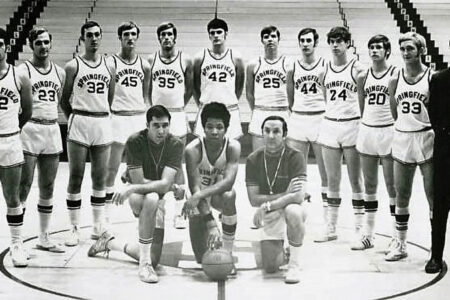It Takes a Village
The expertise of leaders from across the campus has ensured — in a year like no other — that our students' experience also was like no other.
Flatten the curve. Pivot. Unprecedented times. The new normal. Social distancing. Super spreader. The emergence and sustainment of the COVID-19 pandemic changed our lexicon. But, what hasn’t changed is the leadership that defines Springfield College. Since early 2020, the College community has seen campus leaders excel — and those in the background move to the forefront. Meet some of the many unsung heroes on our campus who have led efforts to keep Springfield College whole.
John Mailhot: By the Numbers
For more than 30 years, John Mailhot was the often-invisible face behind keeping Springfield College financially solvent. From associate treasurer to chief accountant to vice president for finance and administration, Mailhot’s oversight of the College annual operating budget ensured positive operational budget results every year amidst three decades of changes in the higher education sector.
And then the COVID-19 pandemic hit, further testing his financial leadership.

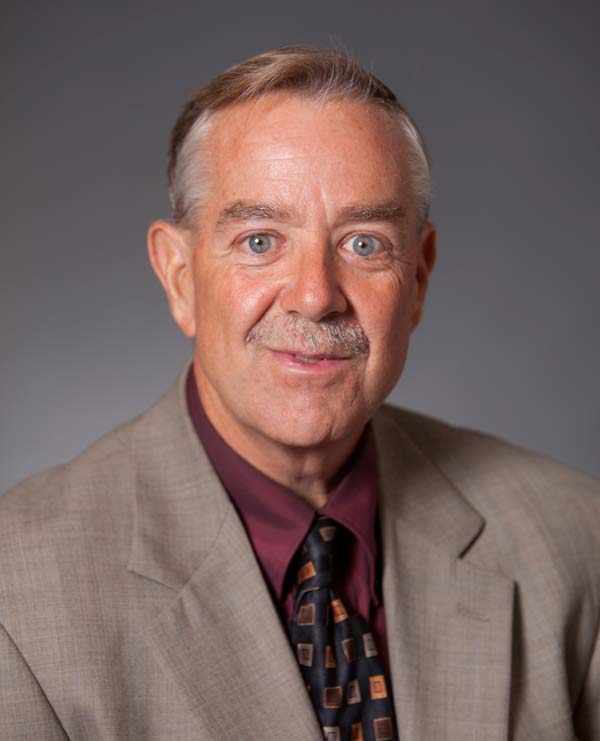
Mailhot and other leaders adjusted budgets at various set dates to provide the best possible chance to end the 2020-21 fiscal year with a balanced operating budget.
In spring 2020, as Springfield College leaders began to understand the increasing complexities that the pandemic would require from a financial perspective, they decided to initiate a “rolling” budget process. The process involved Mailhot and other leaders adjusting budgets at various set dates to mirror actual results related to enrollment, residence hall occupancy, and meal plan utilization, and more to provide the best possible chance to end the 2020-21 fiscal year with a balanced operating budget.
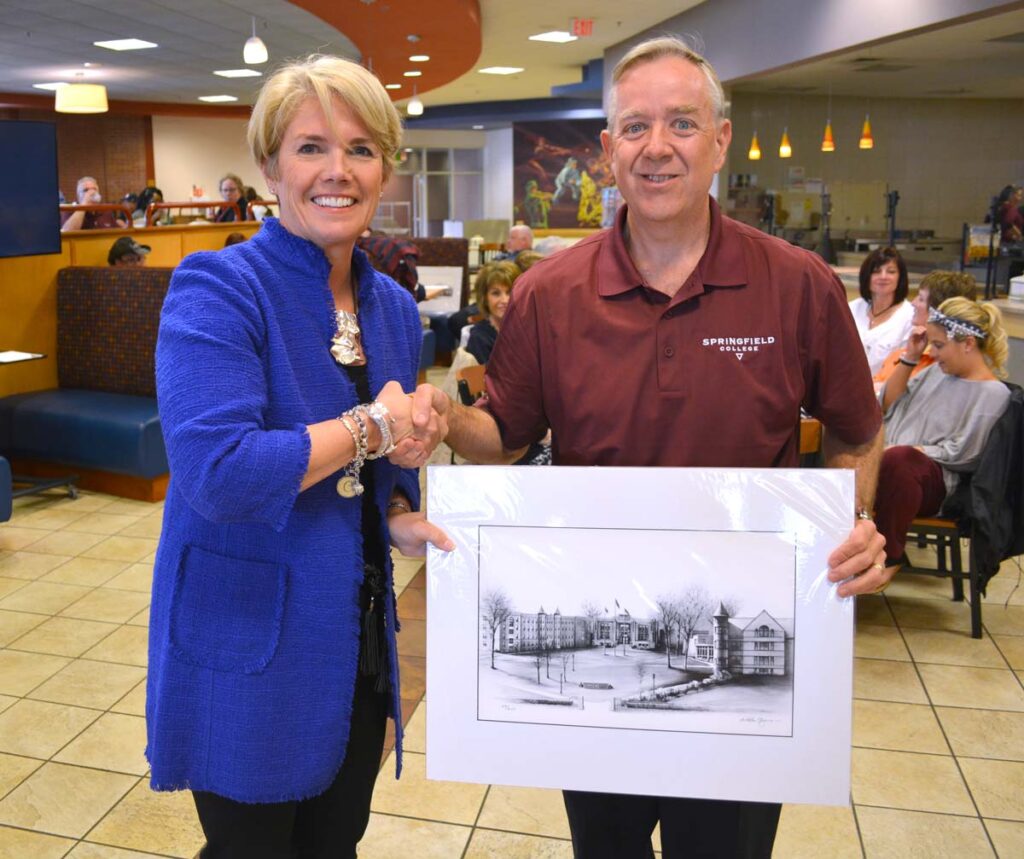
“As a result, adjustments to the original approved operating budget by the Board [of Trustees] in May 2020 were made in early July 2020, September 2020, and February 2021,” Mailhot says. “At this point in time, we are optimistic that these adjustments, which were the result of outstanding support from all areas of the College, will result in positive results for our 2020-21 budget.”
Mailhot announced his retirement from Springfield College in September 2020 but continued to serve until his position was filled. William Guerrero assumed the role of vice president for finance and administration on March 1, 2021. In a part-time capacity, Mailhot helped Guerrero better understand the many areas that he will oversee, including financial aspects of the College, information and technology services, facilities management, and strategic initiatives that are either underway or in the planning process, and more.
President Mary-Beth A. Cooper has said of Mailhot’s dedication to the College, “John has been a key member of the president’s leadership team at Springfield College, and his retirement will certainly be a loss for the campus. We have benefited from his love for Springfield College, his calm in the face of crisis or uncertainty, his expertise, and his commitment to doing what is in the best interest of our students, faculty, and staff.”
Rebecca Kalagher: The Concierge of Help
Rebecca Kalagher considers herself a helper and an organizer. So, when her boss in the Division of Student Affairs, Patrick Love, asked her at the end of October 2020 to take on the extra task of coordinating support for students in isolation and quarantine because of COVID-19, there was no question the answer would be a resounding “yes.”

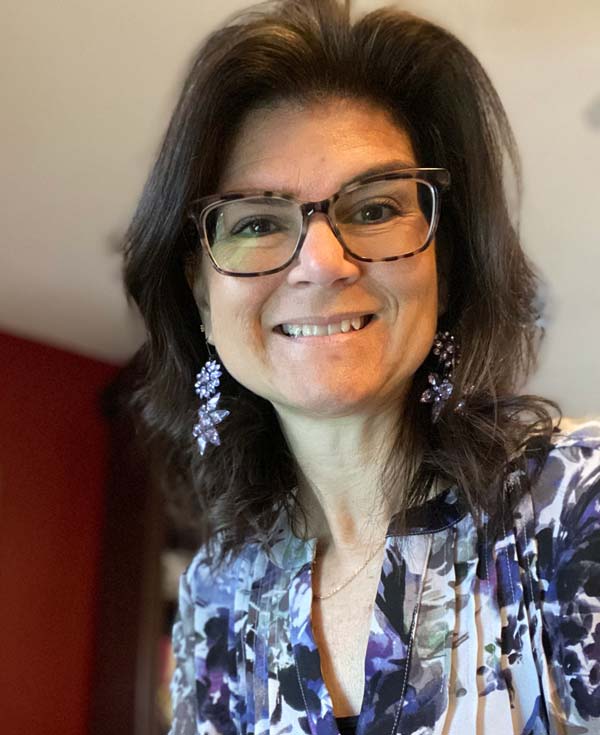
Kalagher embraced the extra task of coordinating support for students who were in isolation and quarantine because of COVID-19.
“I jumped at the opportunity to help out my colleagues, who I had witnessed working extremely hard to support our students,” she says.
This project management job is in addition to Kalagher’s full-time role as an administrative associate in the Office of Student Affairs, primarily in the student conduct/community standards realm. Making sure that students in isolation or quarantine—because they either had tested positive for COVID-19 or were potentially exposed to an infected person—are well supported was a top priority for the College and for Kalagher. She oversees faculty and staff who volunteer to connect with students in those situations.
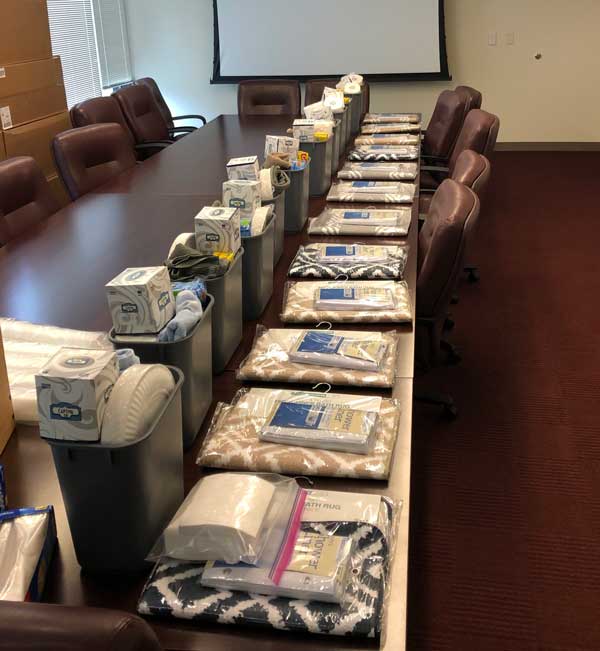
To begin, she developed a script, with the help of Dean of Students Sue Nowlan, G’86, that volunteers use as a guide for their daily check-in conversations with students, recommending that volunteers ask questions about how they’re feeling and whether they received their food from Harvest Table. The guide also encourages volunteers to spend time chatting with students who may be struggling with their situation.
Since October, Kalagher has coordinated the efforts of more than 75 volunteers who have reached out to connect with students. These connections, she says, allow the volunteer and student to “build a rapport and form a deeper relationship.”
“I work and communicate with the volunteer callers across the campus, and have met many new people I probably wouldn’t have had the pleasure of working with,” she says.
Every day, including weekends, Kalagher emails a spreadsheet to the volunteers with all the updated information they need to know before contacting students, and monitors the activity multiple times during the day, responding to volunteers’ questions as needed. Her accompanying email details how many new students have been added, how many students have been released, the status of test results, and any tidbits that need to be shared. Volunteers are asked to reach out to their students by 6:30 p.m. each day.
It’s a lot of responsibility, but Kalagher credits others in the campus community for doing their part to make the experience as positive as possible for students.
“Some of the volunteer callers have gone above and beyond the program’s scope and have personally delivered (contactless) Dunkin’ Donuts, goody bags, or other necessities for the student,” she says. “Where else but at Springfield College are you going to have this personalized, undivided attention to our students in need.”
Christine Johnston: Tracing the Way to Good Health
One key factor in helping curb the spread of COVID-19 is an effective contact tracing system. Rather than relying on the local department of public health (DPH), or a group called the Contact Tracing Collaborative, that responsibility at Springfield College has fallen to a team of about a dozen students trained to do this work.
The benefits of using students are many, not the least of which is identifying students who may have potentially been exposed to COVID-19 more quickly, says Christine Johnston, MPH, assistant director of alcohol and other drug education and health promotion. In addition, Johnston says it is a nicer experience for a student to hear from another student “who can really speak the language of the campus,” especially relaying this kind of news.

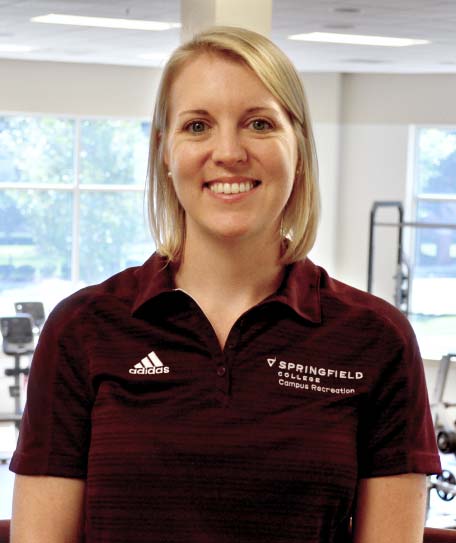
Johnston utilized a team of students to create the rapid contact tracing system on campus.
Johnston has taken on a leadership role in the contact tracing efforts by collaborating with the Health Center staff and overseeing the work of the team of undergraduate and graduate students.
“By being able to contact trace so quickly, I believe that it is helping to keep our COVID case numbers down. We are able to identify contacts the same day and move them to supported quarantine housing, or students can choose to quarantine at home,” she says. “If we waited for the local DPH or Contact Tracing Collaborative to contact trace, the process would be much slower, potentially exposing many more people.”
Johnston’s responsibilities for contact tracing are many, leading her to often work seven days a week, on top of her full-time job.
In August 2020, Johnston hired and trained the students, who are paid for the work, so they were ready for the arrival of students for the fall semester. She conducted refresher training over winter break but there has been a lot of on-the-job learning, especially as protocols change, she notes. Besides training, Johnston’s responsibilities for contact tracing are many, leading her to often work seven days a week, on top of her full-time job. Some nights in the fall semester, Johnston was on the phone late into the evening trying to reach students who may have been exposed.
After receiving reports from the Health Center staff of a positive COVID-19 case, Johnston uses a spreadsheet to track the new cases and their contacts. She helps to populate the data by looking up student phone numbers and addresses. She coordinates with Sue Nowlan, dean of students, and the Office of Residence Life staff, to identify the students who need to move into supported isolation or quarantine housing. The student team members complete most of the calls in addition to routinely connecting with students in quarantine to check in on them and answer questions.
“It’s really hard work and can be stressful. It’s never easy to call someone and let them know they have been exposed to someone with COVID,” Johnston says. “The student team has been great and a huge support to me, as well.”
Another benefit of using Springfield College students is the hands-on experience in a real-world public health situation they gain, as most of them are planning to enter either the medical or public health field once they graduate.
“They are developing great skills for any career, such as the ability to have conversations on the phone, to work as part of a team, to maintain documents, to be organized, and more,” Johnston says.
Harvest Table: A Recipe for Resilience
Serving up a positive dining experience to a college community on any given day takes a lot of collaboration, coordination, and confidence. Add in the ever-changing and unpredictable COVID-19 pandemic, and that experience is magnified.
The team of Harvest Table culinarians, managers, guest associates, and caterers led the way in adapting to the pandemic by making sure the food needs of students were unaffected. What began as a planned renovation of Cheney Dining Hall in February 2020 quickly turned into efforts to build a dining program for students who remained on campus in March while the rest of the student population left to learn from home. The culinarians were motivated to create personalized menus built around fun and exciting themed meals, such as backyard barbecue, for the students on the campus. In a matter of days, they built a mobile ordering dine-out system to allow students to order safely and transformed one section of the Flynn Campus Union into an area for meal pickup.


The Harvest Table team led the way in adapting to the pandemic by making sure the food needs of students were unaffected.
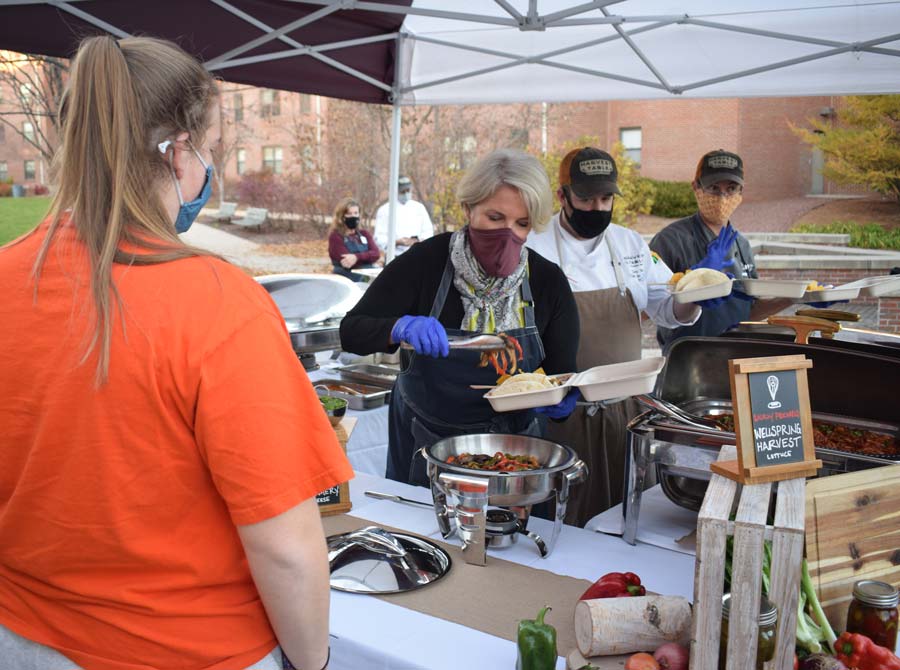
“We collaborated with our students to incorporate recipes from home and quickly added them to our menus for added comfort,” says Hannah Howard, guest experience manager. “It was vital that our remaining students felt right at home with us as the world became a place of uncertainty.”
As the fall semester progressed, so did their expanding work. The Harvest Table staff introduced the GET app in all campus retail locations, allowing students to order ahead while still giving them the flexibility to customize their meals. The staff took to social media to stay connected with students, including using Instagram polls to build the menus. Being agile and adaptable is part of the mantra of Harvest Table, according to Howard.
“We hired more guest associates to serve items at each station, keeping in mind that all items, even down to silverware and napkins, had to be served by an attendant,” Howard says. “We saw this as an opportunity to provide top-notch hospitality.”
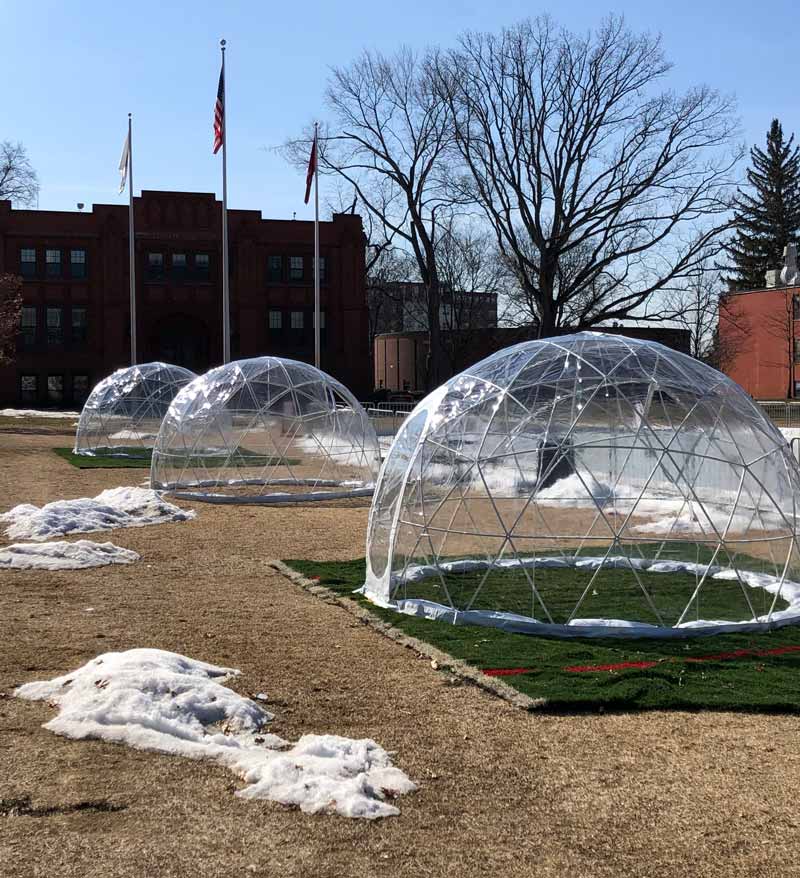
Figuring out how to provide efficient dining services to students in isolation and quarantine was another challenge. Students are asked about their dietary preferences, general food likes and dislikes, and whether they have food allergies. From there, The Harvest Table catering team provides four meals, snacks, and a variety of beverages for each student per day.
“We understand that being in quarantine or isolation can be very frustrating and that our students look forward to meals. Our team builds the meals, labels each box with the student’s name and their needs, and delivers them daily right to their doors while maintaining social distance,” Howard says.
Starting in the fall 2020 semester, the Harvest Table team added the “pop up” dining experience around campus to create a fun and exciting environment. Each week, students are asked via Instagram what food they are craving, and a pop up is developed based on their feedback. One of the favorites of students was the milkshake pop up featuring milk from Maple Line dairy farm in Hadley, Mass., Howard says.
“They love that their voices are heard, and we are able to provide them with fun offerings every week,” Howard says. “We will continue to evolve as the semester goes on and into the summer and fall.”
Patrick Love: Following an Internal Intuition
Foresight. This characteristic is what Patrick Love used to describe his ability to take a leadership role during the COVID-19 pandemic. In February 2020, Love knew the pandemic was no short-term crisis. Intuition led him to push his team in the Division of Student Affairs to consider longer-term issues the College would face.

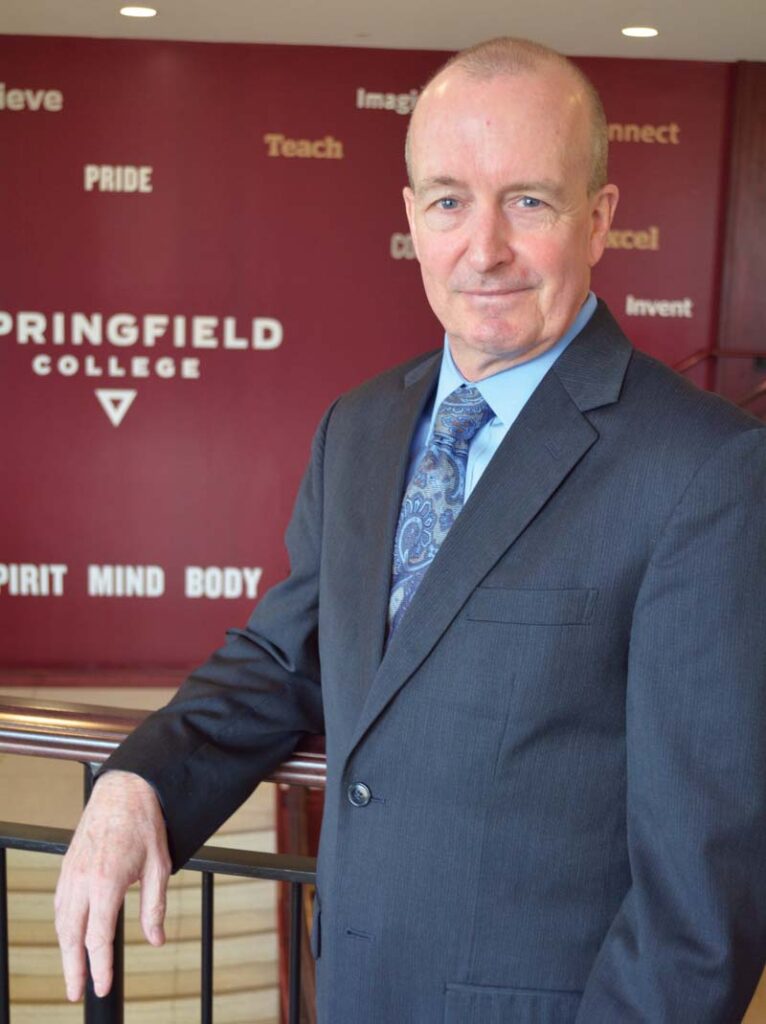
Love knew the pandemic was no short-term crisis. Intuition led him to push his team to consider longer-term issues the College would face.
“As we became enveloped by the pandemic, I realized that we had to do two things in student affairs: transform our student affairs work, and create—from scratch—a public health response to the pandemic,” he says.
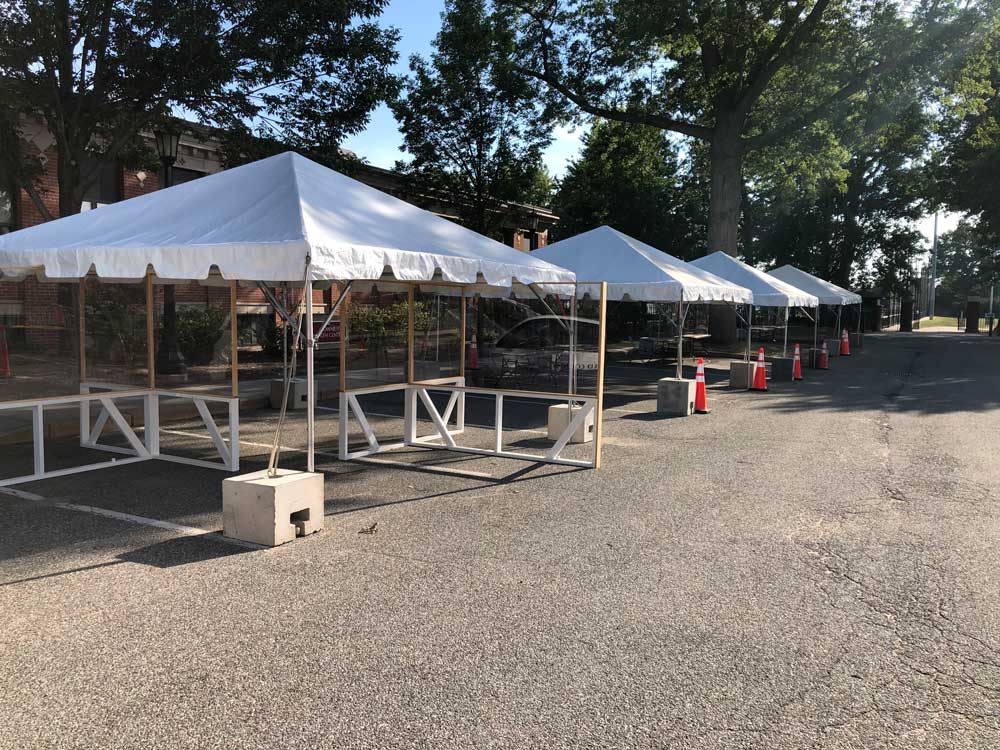
The health response needs were many and required teamwork across the campus community. Some of the responses included creating a research team to read and summarize more than 400 separate documents published about COVID-19; transforming the Health Center into one that operated a COVID-19 testing center; creating and supplying supportive isolation and quarantine housing on campus (moving students, delivering meals to them, and communicating with them daily); de-densifying classrooms, meeting spaces, programming spaces, and Cheney Dining Hall; and initiating various forms of community communication, including the online publication Springfield College Connect.
Student affairs staff altered the landscape so they could continue serving students and the College community. Those efforts included creating a virtual student affairs website; developing the Springfield College Online Orientation Program (SCOOP) that turned the weeklong June orientation program into a summer-long engagement program; quickly converting counseling services from face-to-face to teletherapy; and shifting career services, fitness activities, student activities, and spiritual programming to fully online.
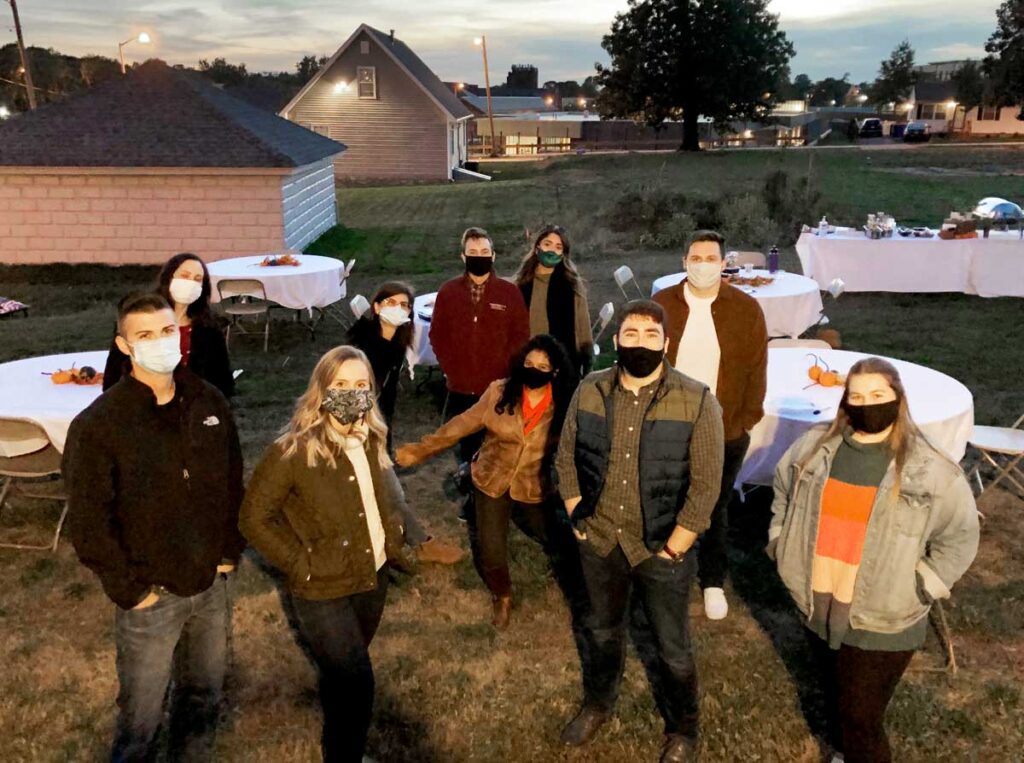
Love is quick to credit many others in the Springfield College community for their willingness and ability to adapt, on top of their regular responsibilities. While he does not feel his leadership has been out of the ordinary, he recognizes that the circumstances of the pandemic have been.
“The other extraordinary thing is the quality of the professionals at Springfield College and the teamwork that has been focused on addressing the challenges facing us,” Love says. “I have worked with many great professionals in my career, but never have I worked with such a large number of outstanding professionals so willing to work together, including Mary Ann Coughlin, G’84, DPE ’87, Sue Nowlan, Kathleen Hogan-Soltys, Christine Johnston, and Kevin Roy among many, many others.”
Love’s background in student affairs before coming to Springfield College is what he believes prepared him to lead during the pandemic. He has dealt with residence hall fires, student deaths, hurricanes (Irene and Sandy) and other emergency weather situations, and major student protests. He found that each of those emergencies and crises helped strengthen his ability to lead and manage. However, nothing prepared him for the length of this pandemic.
“This experience has reinforced for me the importance of allowing and expecting others to exert leadership within their realms of influence and oversight,” he says. “A crisis is not a time for micromanagement.”
Mary Ann Coughlin: Living the Lessons Learned
As a leader on campus in academic affairs, Mary Ann Coughlin’s focus is always on the student learning experience. Maintaining a solid and holistic educational environment is critical to student success. But, that all had the potential to implode when the COVID-19 pandemic emerged in early 2020 and changed higher education, and the world, as we know it.

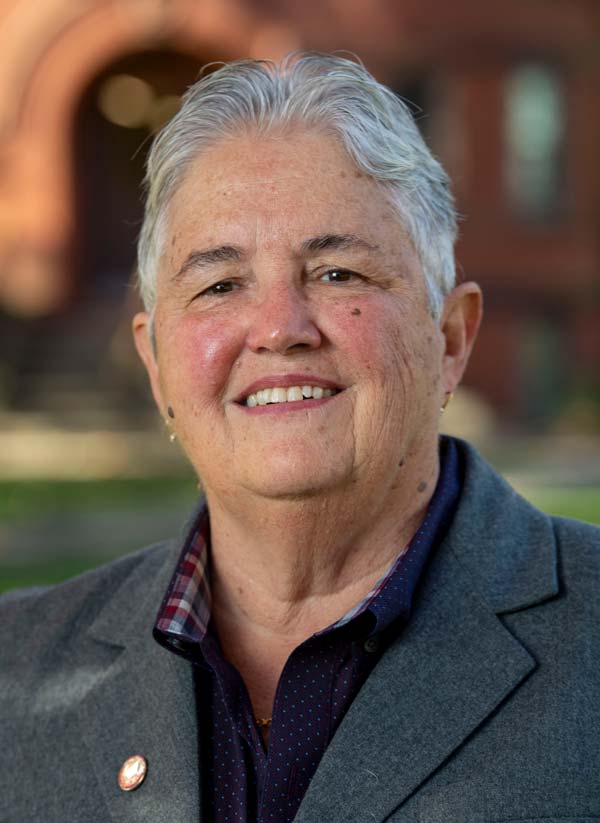
Coughlin had to step beyond her normal responsibilities and drive efforts to try and retain normalcy in academics.
Coughlin, senior associate vice president for academic affairs, had to step beyond her normal responsibilities and drive efforts to try and retain normalcy in academics. Among other new duties, Coughlin co-chaired a planning and implementation team that developed plans related to academics for fall 2020 and spring and summer 2021. She took point on many of those efforts, including everything from collaborating with the facilities management staff on rearranging classrooms so they provide a safe and socially distant environment to working with faculty on the changing status of students (when they failed to follow protocols or did not take the required COVID-19 test).
Coughlin notes that she did not do this alone, and gives special props to two staff members. Leigh-Ann Gomes, G’12, director of academic advising, helped coordinate academic support for students in quarantine and isolation, and was responsible for coordinating with faculty whose students tested positive to the virus. The extra data-driven work of Raldy Laguilles, director of institutional research, did not go unnoticed by Coughlin. Laguilles compiles and distributes all the data about who’s been tested, comparing and coordinating that with who should’ve gotten tested. He also collects all the data on students in isolation and quarantine—critical information that gets passed to affected departments for appropriate response in determining next steps.
“There are many unsung heroes. All of us are just representatives of people who have stepped up in a myriad of ways to provide information, and to support our students and faculty in the classroom and our staff with the work they are trying to do,” she says.
“There are many unsung heroes. All of us are just representatives of people who have stepped up in a myriad of ways to provide information, and to support our students and faculty in the classroom and our staff with the work they are trying to do.”
Mary Ann Coughlin
With the fall 2020 semester completed, Coughlin and her team identified what worked and what didn’t in the first semester to help curb the pandemic on campus. One of the big success stories was the new classroom setup. With the full-on assistance of the facilities management staff, classrooms were arranged with student desks six feet apart from each other and a more than six-foot space between student and faculty in the front of the room, all which proved effective.
“That setup has guided us this semester. We are sticking to that even though the governor said for education spaces, students can be three feet apart,” Coughlin says. “We are saying ‘no that will not work for us’ and we are not messing with it.”
As the current Distinguished Springfield Professor of Humanics, Coughlin is taking the opportunity to chronicle how the College community responded to—and learned from—the COVID-19 pandemic. She will use her firsthand knowledge of all the College planning and reflect on what these experiences mean in terms of the Humanics philosophy.
“We talk all the time that the Humanics philosophy is a cornerstone of our institution. While some people think it hasn’t changed, that isn’t really true,” Coughlin says. “It changes as we change, as we live it out.” In advance of her Distinguished Springfield Professor of Humanics Lecture given in April, she remarked, “I want to really talk about what does that philosophy mean and what lessons should we take on and move forward.”![]()

